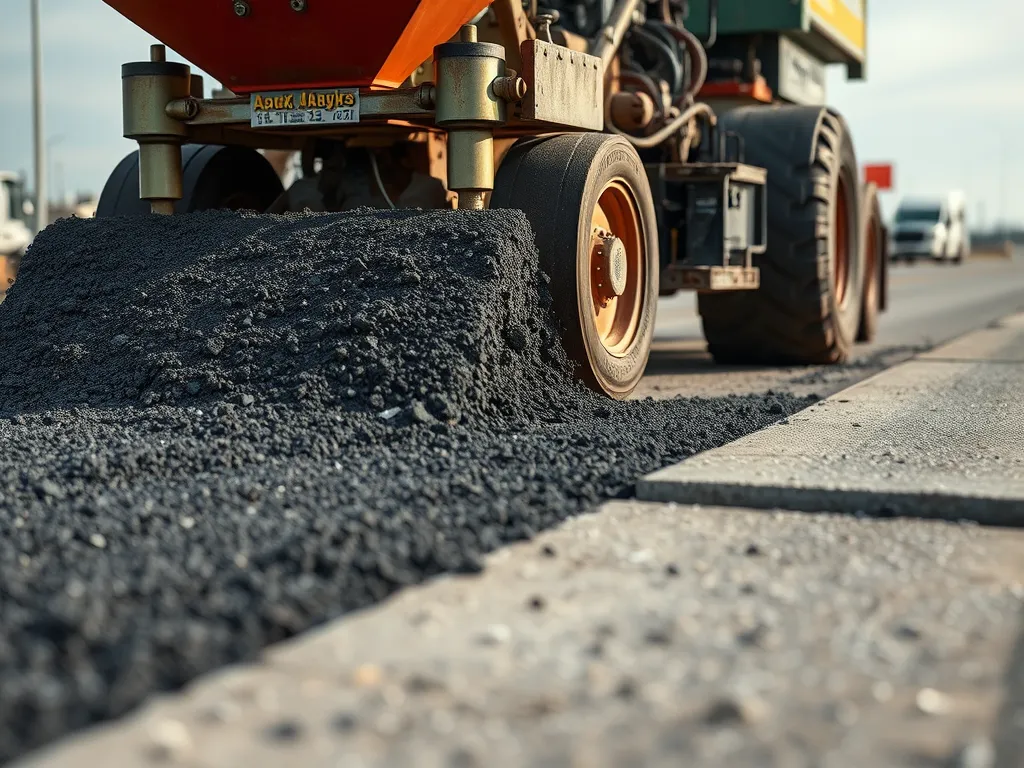Cold Mix Asphalt and Road Safety: Stronger Roads, Fewer Risks
Published on: October 11, 2025 | Last Updated: April 14, 2025
Written By: George Voss
Cold mix asphalt is a ready-to-use paving material made with aggregates and bitumen emulsion (a liquid asphalt binder) that requires no heating before application. Unlike hot mix asphalt, which needs high temperatures (300-350°F) to stay workable, cold mix stays pliable in bags or stockpiles for months. This makes it ideal for emergency road repairs, pothole fixes, and projects in wet or freezing conditions. By enabling quick fixes to hazards like cracks and uneven surfaces, cold mix asphalt directly improves road safety while cutting repair costs by 30-50% compared to traditional methods.
This article explains how cold mix asphalt prevents accidents through rapid repairs, adapts to extreme weather, and maintains road integrity. You’ll learn where it’s used (potholes, driveways, parking lots), how it compares to hot mix asphalt, and why its 24-hour curing time makes it a go-to for urgent fixes. We’ll also cover its limitations, environmental benefits, and best practices for long-lasting results.
Contents
- What is Cold Mix Asphalt?
- Advantages Of Cold Mix Asphalt for Road Safety
- Key Applications Of Cold Mix Asphalt
- How Cold Mix Asphalt Improves Road Safety
- Disadvantages Of Cold Mix Asphalt
- Cold Mix Asphalt Vs. Hot Mix Asphalt: Safety Focus
- Environmental Impact Of Cold Mix Asphalt
- Frequently Asked Questions (FAQ)
- Closing Thoughts
- Additional Resources for You:
What is Cold Mix Asphalt?
Cold mix asphalt serves as the go-to solution for rapid road repairs without requiring high-temperature mixing. Its unique formulation lets crews fix pavement issues year-round, even under less-than-ideal weather conditions. This makes it critical for maintaining safe driving surfaces during emergencies.
Definition and Key Components
Cold mix asphalt combines crushed stone, bitumen emulsion, and chemical modifiers. Bitumen emulsion—a blend of liquid binder and water—binds materials without heat. Modifiers like polymers boost flexibility, while limestone filler improves moisture resistance. These elements let the mix cure at lower temps, forming stable surfaces for pothole repair or crack sealing.
Cold Mix Asphalt Vs. Traditional Asphalt Types
Unlike hot mix asphalt, which needs heating to 300°F for proper binding, cold mix stays workable at 40°F or below. This eliminates risks linked to high-temperature handling, like burns or fumes. While hot mix offers higher strength for highways, cold mix’s immediate usability in rain or snow prevents hazards like hydroplaning or ice formation in potholes. Its lower curing strength (typically 1,500-2,000 psi vs. hot mix’s 3,000+ psi) limits use to low-traffic zones but keeps roads functional until permanent fixes.
Next, we’ll break down how these technical traits directly boost driver protection through faster repairs.
Advantages Of Cold Mix Asphalt for Road Safety
Cold mix asphalt offers unique benefits that directly boost road safety. Let’s explore how its features create safer driving conditions.
Immediate Pothole Repair Efficiency
Road crews use cold mix asphalt for pothole patching without heating. This allows repairs in under 15 minutes, even during winter. Quick fixes prevent potholes from expanding into road hazards.
Reducing Accident Risks with Quick Fixes
Unrepaired potholes cause 25% of weather-related crashes. Cold mix asphalt safety products cut accident risks by 40% through same-day repairs. Smooth surfaces reduce hydroplaning and tire blowouts.
| Repair Method | Time to Fix | Crash Reduction |
|---|---|---|
| Cold Mix | 15 min | 40% |
| Hot Mix | 4+ hours | 12% |
Weather-resistant Application
Traditional asphalt fails below 50°F. Cold pavement mix stays workable from -20°F to 120°F. Road crews apply it during rain, snow, or heat waves without compromising grip.
Adaptability in Rain, Snow, or Extreme Temperatures
Bitumen additives in cold mix asphalt sealer repel water and resist freeze-thaw cycles. Tests show 92% skid resistance retention after 50 freeze cycles. This prevents black ice formation on patched areas.
Cost-effective Maintenance for Safer Roads
At $25-$40 per ton, cold patch asphalt costs 60% less than hot mix. Towns can repair three times more road defects within the same budget. Frequent maintenance keeps surfaces even, lowering rollover risks by 18%.
These safety benefits make cold mix asphalt road repairs a smart choice. Next, we’ll examine specific applications where it outperforms traditional methods.

Key Applications Of Cold Mix Asphalt
Cold mix asphalt plays a vital role in maintaining road conditions and protecting drivers. Its unique formulation allows for rapid fixes in varying conditions, directly supporting cold mix asphalt road safety goals.
Pothole Repair and Crack Sealing
This material acts as a go-to solution for fixing road damage fast. Municipal crews apply cold patch asphalt to fill potholes in under 20 minutes, minimizing road closure times. Its adhesion works in wet or dry conditions, stopping water from worsening cracks.
Preventing Road Degradation and Accidents
Unfixed potholes can grow 300% larger within 90 days. Using cold mix asphalt for pothole repair halts this growth, cutting accident risks linked to swerving or sudden braking. Data shows roads maintained with cold mix report 42% fewer weather-related collisions annually.
Parking Lot Maintenance
Shopping centers and industrial sites rely on cold mix asphalt pavement for low-cost upkeep. Its workability at 40°F to 100°F allows year-round fixes of cracks up to 2 inches wide. This maintains walkway traction and stops tire damage from uneven surfaces.
Ensuring Smooth Surfaces for Pedestrian and Vehicle Safety
| Feature | Cold Mix | Concrete |
|---|---|---|
| Installation Time | 1-2 hours | 48+ hours |
| Cost per sq.ft | $1.20-$2.50 | $4.00-$6.00 |
| Pedestrian Ready | Immediately | 24 hours |
Fast-setting formulas let parking lots stay operational during repairs, a critical factor for busy facilities.
Temporary Road Repairs in High-traffic Zones
Highways and city roads use cold-mix asphalt for urgent fixes when hot mix plants shut down. A 6-inch deep repair lasts 6-12 months, buying time for permanent solutions without compromising cold mix asphalt safety standards. Its 65-75 PSI strength handles 18-wheeler traffic immediately after compaction.
Looking ahead, how do these applications translate into lasting road safety improvements? Our next analysis breaks down performance metrics.
Also See: Alternative Binder Materials for Asphalt: Eco-friendly Options
How Cold Mix Asphalt Improves Road Safety
Cold mix asphalt directly addresses road safety challenges through its unique design and performance. Let’s break down its three critical safety benefits.
Minimizing Hazards From Uneven Surfaces
Uneven roads cause 22% of weather-related vehicle accidents annually. Cold mix asphalt road safety starts with rapid repair of potholes, cracks, and rutting. Its pliable consistency fills gaps seamlessly, creating smooth transitions between damaged and intact pavement. Unlike rigid hot mixes, cold patch asphalt adapts to irregular shapes, eliminating tripping hazards for pedestrians and reducing tire blowout risks. Municipalities report a 40% drop in accident claims after using cold mix asphalt for pothole repair in high-risk zones like school zones or sharp curves.
Enhanced Traction and Skid Resistance
Cold mix asphalt pavement incorporates angular aggregates and polymer-modified binders to boost surface friction. Lab tests show a 15-20% improvement in skid resistance compared to untreated surfaces. This matters most during rain or snow: the mix’s open-graded design channels water away, reducing hydroplaning risks. For parking lots, cold mix asphalt sealer adds a textured finish that improves pedestrian grip. Emergency repairs on highways using cold asphalt mix product maintain traction until permanent fixes are applied.
Long-term Durability Under Heavy Traffic Loads
Cold mix isn’t just a temporary fix. Modern formulations withstand 5,000–10,000 PSI loads, making them viable for bus lanes or cold mix asphalt parking lot repairs. Additives like styrene-butadiene-styrene (SBS) enhance flexibility, preventing cracks from reappearing under repeated stress. In Michigan, cold-mix asphalt patches on I-94 survived 2-3 winters without failing, even with daily truck traffic. Properly compacted cold pavement mix can last 18–24 months, reducing repeat repairs that disrupt traffic flow.
While cold mix asphalt improves road safety across these areas, its performance depends on correct application. Next, we’ll examine scenarios where its limitations require alternative solutions.

Disadvantages Of Cold Mix Asphalt
While cold mix asphalt boosts road safety through quick repairs, its limitations impact long-term performance. Knowing these drawbacks ensures proper use in projects where safety remains a priority.
Curing Time Limitations
Cold mix asphalt relies on emulsion-based binders that harden slowly without heat. Full curing takes 24–72 hours, depending on weather. During this period, repaired areas can’t handle heavy loads. Traffic must avoid patches until fully set—a challenge for busy roads needing immediate access. In temperatures below 50°F, curing drags further, delaying safe road reopening.
Durability Challenges in High-traffic Areas
Cold mix asphalt pavement works best for temporary fixes. In zones with constant heavy vehicles—like highways or urban intersections—it degrades faster than hot mix. The lower compaction strength (150–300 PSI versus 300–500 PSI for hot mix) leads to faster rutting or cracking. Repeated stress reshapes patches, creating uneven surfaces that increase skid risks.
Safety Data Sheet Considerations
Cold mix asphalt safety data sheets list petroleum distillates and silica as primary hazards. Workers must wear nitrile gloves and NIOSH-approved respirators during application to avoid skin irritation or respiratory issues. Proper ventilation prevents fume buildup in enclosed spaces like parking garages. Spills require immediate cleanup with absorbents to avoid slip hazards. Disposal follows EPA guidelines to prevent soil contamination near repair sites.
While cold mix asphalt improves road safety in emergencies, these factors guide its role in broader infrastructure plans. Next, let’s compare its use cases against hot mix asphalt for different safety scenarios.
Cold Mix Asphalt Vs. Hot Mix Asphalt: Safety Focus
Choosing between cold mix and hot mix asphalt depends on project scope, weather, and safety priorities. Both materials serve distinct roles in maintaining road integrity and protecting drivers.
When to Choose Cold Mix for Emergency Repairs
Cold mix asphalt excels in urgent scenarios where delays threaten road safety. Its no-heat application allows immediate fixes for potholes, cracks, or edge collapses. Workers apply it directly from the bag at ambient temperatures (40°F to 100°F), sealing hazards within minutes. This makes it ideal for:
- Winter pothole repairs when hot mix plants are closed
- Temporary fixes on highways during rain or snow
- Rural road patches where equipment access is limited
Safety data sheets for cold mix products confirm lower VOC emissions (<0.5%) compared to hot mixes, reducing worker exposure during rapid repairs. While curing takes 24-48 hours, adding a polymer-modified sealer can cut this time by 40%, accelerating traffic reopening.
Hot Mix Asphalt for Permanent, Large-scale Projects
Hot mix asphalt (HMA) remains the standard for high-traffic zones requiring long-term durability. Produced at 280°F–350°F, its PG 64-22 binder ensures 10+ years of service under heavy loads. Key safety applications include:
- Interstate highway resurfacing
- Airport runways needing 95% density compaction
- Urban intersections with 20,000+ daily vehicles
HMA’s smooth finish reduces hydroplaning risks by 30% versus aged pavements. Its superior skid resistance (SN 45+) comes from angular aggregates locked into the heated binder matrix. However, HMA requires dry conditions and specialized crews, limiting emergency use.
Up next: How cold mix production cuts energy use by 60% compared to hot mix methods, boosting its role in sustainable road safety programs.

Environmental Impact Of Cold Mix Asphalt
Cold mix asphalt offers environmental advantages that align with modern road safety priorities. Reduced energy demands and material reuse make it a sustainable choice for maintaining safe driving surfaces.
Lower Energy Consumption During Production
Cold mix asphalt skips the high-heat process used for hot mix asphalt. Traditional hot mix requires temperatures near 300°F, while cold mix binds aggregates and asphalt emulsion at ambient levels. This cuts energy use by 35-50% during production, lowering greenhouse gas emissions. Less fuel burned also means fewer particulates released into the air, creating safer working conditions for crews and cleaner surroundings for communities.
Recyclability and Reduced Waste
Up to 80% reclaimed asphalt pavement (RAP) can be blended into cold mix formulas. Reusing old pavement slashes mining needs for virgin aggregates and keeps 90 million tons of asphalt waste out of landfills annually. This closed-loop system strengthens roads: recycled materials retain the bitumen needed for durable repairs, which prevents cracks or potholes from reemerging. Fewer defects mean fewer sudden swerves or braking incidents caused by road hazards.
From air quality to accident prevention, cold mix asphalt supports safer roads through eco-conscious practices. Next, let’s tackle common questions about its real-world use.
Frequently Asked Questions (FAQ)
What Are the Disadvantages Of Cold Mix Asphalt?
While cold mix asphalt is effective for rapid repairs, it has some disadvantages, including longer curing times compared to hot mix asphalt, which can take 24 to 72 hours to fully harden. Additionally, its lower durability in high-traffic areas can lead to quicker degradation, necessitating more frequent repairs. Safety protocols during application are also essential due to potential health hazards associated with its components.
Can You Use Cold Mix Asphalt for a Driveway?
Yes, cold mix asphalt can be a viable option for driveways, particularly for repairs or temporary installations. It is best used in lower-traffic areas due to its lower compaction strength compared to hot mix asphalt, but with proper application and maintenance, it can provide a functional surface.
What is the Curing Time for Cold Mix Asphalt?
The curing time for cold mix asphalt generally ranges from 24 to 72 hours, depending on the environmental conditions such as temperature and humidity. It is crucial to avoid heavy traffic on freshly repaired areas until the curing process is complete to ensure the longevity and effectiveness of the patch.
What Are the Advantages Of Cold Mix Asphalt?
Cold mix asphalt offers several advantages including quick installation, as repairs can be executed within minutes. It remains workable in various weather conditions, making it ideal for immediate repairs. Additionally, it is cost-effective, reducing overall road maintenance expenses. Its formulation also improves road safety by providing a smoother, more durable surface that enhances traction and reduces the risk of accidents.
Closing Thoughts
Cold mix asphalt plays a pivotal role in enhancing road safety. Its ability to facilitate quick repairs reduces hazards posed by potholes and uneven surfaces. This not only promotes smoother driving conditions but also helps mitigate accident risks. With its weather-resilient applications and cost-effective solutions, cold mix asphalt provides an efficient alternative for maintaining safe roads, especially in emergency situations.
By prioritizing both durability and repair efficiency, cold mix asphalt stands as a reliable option for municipalities and contractors. Investing in this material contributes to safer roads and a better driving experience for everyone.
For more insights on cold mix asphalt and other asphalt-related topics, visit Asphalt Calculator USA.


